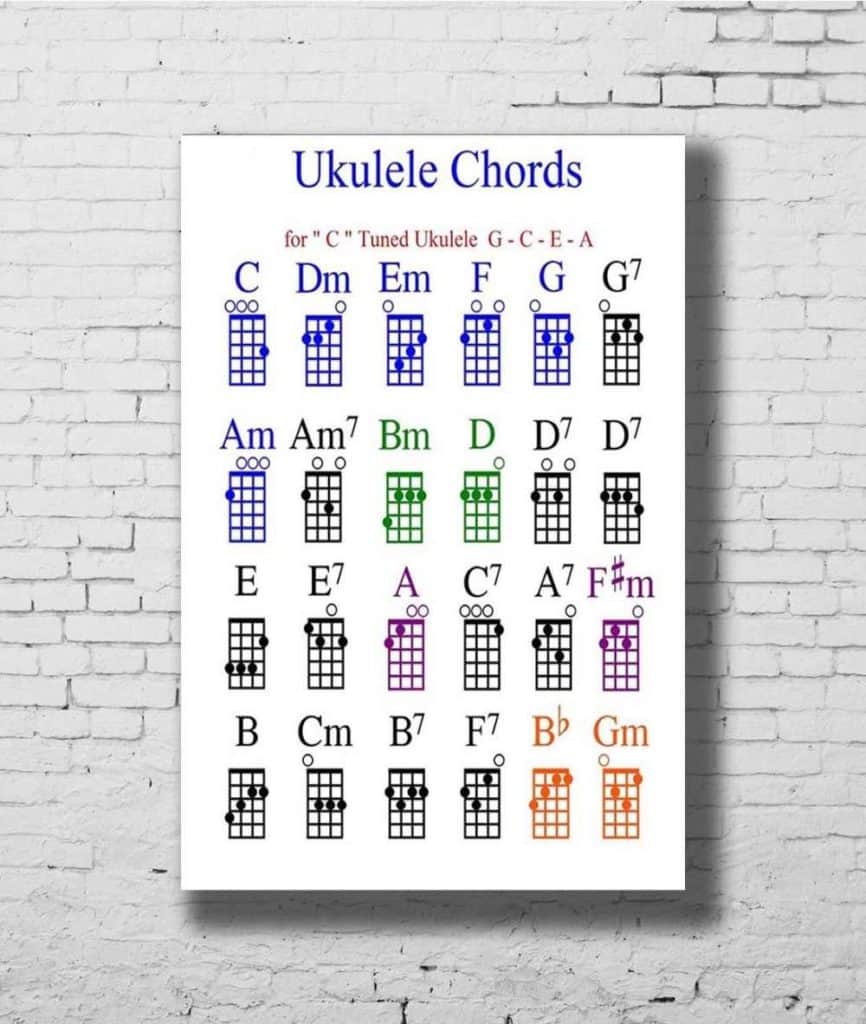The first thing we are taught when learning to play the ukulele is, how to strum correctly and a few of its major chords. Learning chords not only helps you to pick up songs of your choice, but it also helps to boost your confidence in playing the instrument well. The chord progression, which is changing from one chord to another, is one thing which is very important when learning a ukulele. The quicker and smoother you transition, the easier it will be for you to pick up songs. Ukulele Chord Chart for Beginners helps you learn the chords easily.
Ukulele Chord Chart Basics
For starters, there are four strings in a Ukulele, similar to a bass guitar. Secondly, you’ll have to know how to hold the instrument in a proper manner, which is positioning one hand (depending on whether you use your righty or a lefty) between the Ukulele’s neck and its soundhole.
Before we start taking a look at the ukulele chord chart, keep in mind which finger each number represents.
- 1 represents the index finger
- 2 represents the middle finger
- 3 represents the ring finger
- 4 represents the pinkie finger
Let us understand the keys involved
Given below is a list of all the keys which will be included in the Ukulele Chord Chart.
- A
- B♭ or A#
- C
- B
- D♭ or C#
- D
- E
- E♭ or D#
- F
- G
- G♭ or F#
- A♭ or G1
However, keep in mind that we will not be looking at all the chords because some of them require extreme practice and swift movement of the fingers. Here, we will only be looking at the basic chords from each key, including the chord of the key itself.
Let’s look at the chords based on each key
(P.S. – Not all chords are given because like we have already mentioned above, it won’t be possible for a beginner to play them. The ones given below are from the most basic Ukulele Chord Chart, just to help you get started.)
- A Key – The middle finger (2) is placed on the second fret of the first string and the index finger (1) is placed on the first fret of the second string. The third and fourth strings are left open.
- Bb or A# Key – The index finger (1) is placed on the third fret of the fourth string, the middle finger (2) is placed on the second fret of the third string, the ring finger (3) and pinkie are placed on the first fret of the third and fourth strings respectively.
- B Key – The pinkie (4) is placed on the fourth fret of the fourth string, the ring finger (3) is placed on the third fret of the third string and the middle finger (2) and index finger (1) are placed on the second fret of third and fourth strings respectively.
- C Key – All the strings are left open except the fourth string where the index finger (1) is placed on the third fret.
- Db or C# Key – The index finger (1), the middle finger (2) and the ring finger (3) are placed on the first fret of the first, second and third strings respectively. The pinkie (4) is placed on the fourth fret of the fourth string.
- D Key – The index finger (1) is placed on the second fret of the first string, the middle finger (2) is placed on the second fret of the second string and the ring finger (3) is placed on the second fret of the third string. The fourth string is left open.
- Eb or the D# Key – The first string is left open. The middle finger (2) is placed on the third fret of the second string, the ring finger (3) is placed on the third fret of the third string and the index finger (1) is placed on the first fret of the fourth string.
- E Key – The index finger (1) is placed on the first fret of the first string. The ring finger (3) is placed on the fourth fret of the second string. The third-string is left open and the middle finger (2) is placed on the second fret of the fourth string.
- F Key – The middle finger (2) is placed on the second fret of the first string, the second string is left open, the index finger (1) is placed on the first fret of the third string and the fourth string is left open.
- Gb or the F# Key – The pinkie (4) is placed on the third fret of the first string, the index finger (1) is placed on the first fret of the second string, the ring finger (3) is placed on the second fret of the third string and the middle finger (2) is placed on the first fret of the first string.
- G Key – The first string is left open. The index finger (1) is placed on the second fret of the second string, the ring finger (3) is placed on the third fret of the third string and the middle finger (2) is placed on the second fret of the fourth string.
- Ab or the G# Key – The pinkie (4) is placed on the fourth fret of the first string. The index finger (1) is placed on the second fret of the second string, the ring finger (3) is placed on the third fret of the third string and the middle finger (2) is placed on the second fret of the fourth string.
These are the twelve main key chords which you must learn to play before moving towards more complex chords. Since they are the major chords, it is from them that you learn to play the other minor chords.
Musical instruments hold divinity and mystique within them, so much that we cannot help but get lost in their charm. Musical mastery requires patience, passion, and skill. Stringed instruments hold a special place here, for they become the finest as time progresses. The older these instruments are, the better they perform.
Well, we all know about violins and guitars. Why not try something new? Ever heard of a Ukulele? Descending from the family of the ‘lute instruments,’ this instrument seems like a guitar but isn’t. Made of wooden body and nylon strings, the ukulele is nothing less than a heavenly transcendence.
Why Ukulele?
Whenever we talk about something different from the normal, the obvious question is, why? We’d give you tons of reasons for grabbing a Ukulele. Some of them are as follows:
- Eye-to-hand coordination
- Improved neural function
- Reduced stress levels
- Posture correction
- Respiratory balance
This doesn’t stop here! There is so much more from a Ukulele. We wondered why people never thought about this beauty so far. Many people across the globe started diving into this instrument, proving us wrong! So, we couldn’t stop but help you guys in understanding the basics of this instrument.
Ukulele Beginners’ Chord Chart
Previous knowledge about anything always pays off. We feel that being a beginner is advantageous in any scenario, for we’d have so much to learn! On that note, here we are with the very basics of the ukulele – the basic ukulele chord chart. All the excellent tunings from the ukulele like the Tenor, Soprano, Bass, etc., are a result of mastering this basic ukulele chord chart.
A ukulele can be played with ease if we are familiar with the ukulele chord chart with finger numbers. Each number from this chart represents a finger of our hand using which we differentiate the chords and compose the tunes. Read on to find out what a ukulele chord chart with finger numbers means before you grab the instrument!
Thus, practice and learn these chords well and try the progression of chords too, to understand quick changes, which will in turn aid in playing the more complex chords.
Happy strumming!

Hi, I am William. I am a music enthusiast. I play the guitar and ukulele. I like to try out all instruments and review them, to help others make an informed decision. You must choose the right instrument to get that sweet sound you desire. When I am not on my instruments I will be found reading or cooking.






